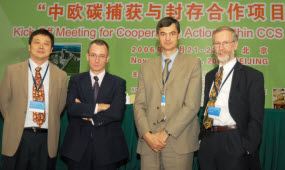
|
Sino-European fraternisation for the good of the climate. This quartet will play a central role in the Coach project. From the left: Li Gao of the Chinese Administrative Centre for Agenda 21, Pierre Deschamps of the EU Commission, François Kalaydjian of IFP and Jens Hetland, senior scientist at SINTEF Energy Research. (Photo: SINTEF) |
In 2005 alone, the country increased its generating capacity by no less that 52 Gigawatts (GW). If newbuilding continues at the same rate, without CO2 capture, levels of CO2 in the atmosphere will literally hit the skies.
At the same time, it is clear that the low level of costs in China make it much cheaper to build fossil-fuelled power stations with CO2 capture in China than in Europe.
This was the backcloth for SINTEF’s proposal just over a year ago for a Sino-European project that would make it easier to unite the interests of quota-hungry Europeans and electricity-hungry Chinese.
Coal-based electricity – with CO2 capture
The three-year cooperative Coach project, with a budget of €3 million (just over NOK 24 million), which has just been agreed by the EU Commission and China’s Ministry of Science and Technology, started up just before Christmas last year.
The project is dedicated to coal-based generation of electricity and fuel – with CO2 capture, and is a twin of the EU’s Dynamis project, which is led by SINTEF.
Dynamis was the start of an offensive aimed at reducing emissions that the EU has launched on the home front. The aim is to develop a full-scale coal or natural gas-fired demonstration plant electricity generation and hydrogen production – with CO2 capture. The plant is to be in operation by 2012 – 2015.
In the Dynamis project, representative of industry and researchers will consider just where in Europe this plant should be located, and what technology it ought to employ. In Coach, eleven European and nine Chinese industrial companies, universities and research organisations will carry out a similar evaluation process – but this time in China.

|
Not exactly blue skies: pollution from coal-fired power stations and industry – most sulphur and nitrogen compounds (photochemical smog) lay thickly over Beijing for the whole of the week in which the Sino-European project was launched just before Christmas last year. Photo: Jens Hetland, SINTEF |
Easier to find investment objectives
Among other activities of the Coach project, its members will identify which of China’s ageing coal-fired power stations will be replaced by new plants.
They will also evaluate which of the new-building projects are most suitable for CO2 capture – and recommend what sort of technology and methods should be used to deal with the CO2 produced by individual power plants.
“The results will make it easier for European companies to circle in development projects that would make attractive investment objects with a view to buying up emission quotas in the future”, says senior scientist Jens Hetland of SINTEF Energy Research, who leads one of the six sub-projects that make up Coach.
Arena for positioning
The SINTEF scientist explains that the project will offer European industry the prospect of benefits in addition to those of buying up quotas.
“Coach will give European suppliers an opportunity to position themselves on a future Chinese market for CO2 capture technology. Coach will also give both Europeans and Chinese the chance to develop joint CO2 technology for use elsewhere in the world”, says Hetland.
Electricity and hydrogen
In order to make itself independent of major imports of oil and gas, China is keen to develop its national energy supply, so that the country’s huge coal deposits can be gasified.
This will involve transforming coal into hydrogen-rich gas that can be used as fuel in both power plants and the transport sector, in the form of pure hydrogen and synthetic petrol and diesel oil. With CO2 in plants of this sort, the CO2 is removed before electricity generation and is then deposited, preferably un underground porous rocks.
“The Chinese will also build pure coal-fired power stations in which the CO2 will be removed after the combustion stage. One of the tasks of Coach will be to find out where in China one or the other concept will be most appropriate,” says Hetland.
The French petroleum institute IFP in Paris is coordinator of the Coach project, in which SINTEF has a NOK 3.2 million share.
By Svein Tønseth
